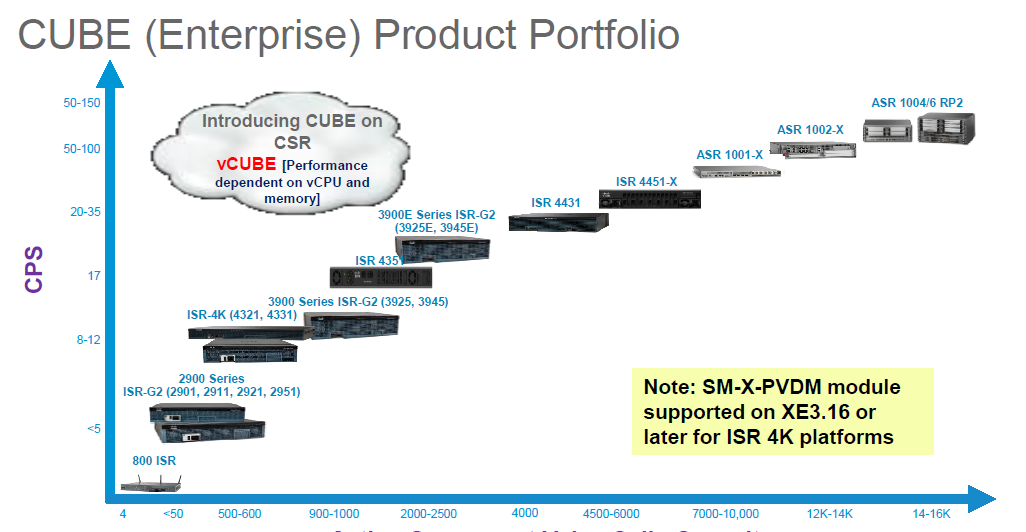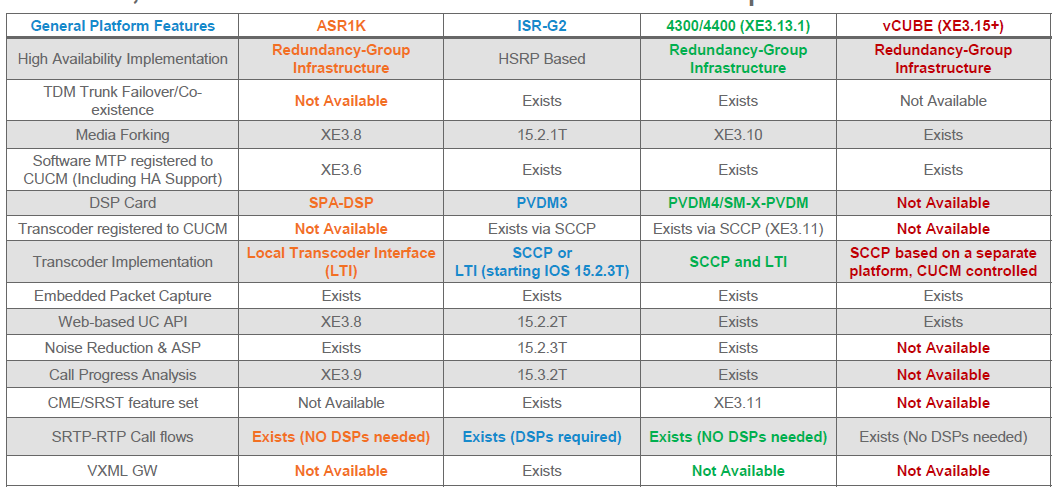- Cisco Community
- Technology and Support
- Collaboration
- Other Collaboration Subjects
- Re: Difference between Cisco SBC and CUBE
- Subscribe to RSS Feed
- Mark Topic as New
- Mark Topic as Read
- Float this Topic for Current User
- Bookmark
- Subscribe
- Mute
- Printer Friendly Page
Difference between Cisco SBC and CUBE
- Mark as New
- Bookmark
- Subscribe
- Mute
- Subscribe to RSS Feed
- Permalink
- Report Inappropriate Content
07-08-2015 03:17 PM - edited 03-13-2019 09:03 PM
Hi,
Could someone please explain me the difference between Cisco SBC (Session Border Controller) and CUBE (Cisco Unified Border Element)?
Thank you very much!
Samuel
- Mark as New
- Bookmark
- Subscribe
- Mute
- Subscribe to RSS Feed
- Permalink
- Report Inappropriate Content
07-10-2015 01:20 PM
Hi there - Cisco Unified Border Element (CUBE) is a session border controller for enterprises. Service providers also use session border controllers in their networks but the requirements carriers are much different than for enterprises.
Information on CUBE can be found here: www.cisco.com/go/cube.
Hope this helps,
- Mark as New
- Bookmark
- Subscribe
- Mute
- Subscribe to RSS Feed
- Permalink
- Report Inappropriate Content
07-14-2015 07:48 AM
Thanks for the answers pmertz!
- Mark as New
- Bookmark
- Subscribe
- Mute
- Subscribe to RSS Feed
- Permalink
- Report Inappropriate Content
06-01-2016 05:29 AM
Hi friend
have you ever implement SBC or CUBE? I have some question on implementation and also licensing.
thanks
- Mark as New
- Bookmark
- Subscribe
- Mute
- Subscribe to RSS Feed
- Permalink
- Report Inappropriate Content
06-20-2016 03:32 AM
As Far as i can tell a Cube is a Cisco SBC, there is no diffrence both names refer the same platform
there are also other vendors like acme packet and audio codes with have SBC plaforms
In terms of Scalability currently we have ISR G2, ISR-4K, ASR, CSR-1000V (Vcube) hardware that suporte Cube functionality, the scalling is in terms of concurrent sessions and the hardware varies according to your needs.
In terms of licenseing it depends on the type of hardware and the OS of it . If it is IOS there is a specific SKU for cube sessions (FL-CUBE), these licenses are right to use, the max capacity of sessions is still defined by the hardware .There is also specific license for redundancy
The hardware can also be ASR and V-cube witch use IOS XE in witch the configuration is a bit diferent. In therms of features supported:

Hope this helps
Regards,
Nuno
.
- Mark as New
- Bookmark
- Subscribe
- Mute
- Subscribe to RSS Feed
- Permalink
- Report Inappropriate Content
06-25-2016 03:23 AM
Hi
I am completely get confused between the SBC and CUBE configuration. cisco has two configuration guide ; one for SBC and one for CUBE and they are completely different, for SBC we should configure SBE and DBE and some adjacency and .....
but for CUBE we should configure Dial-peer and ....they are completely different. ![]()
we have one soft switch in our network from one side it is connected to Media-Gateway and finally is connected to PSTN, from other side it should be connected to some SBC, and finally to SIP-user.
the SBC roles are:
1-Network hiding: I mean the SIP-user don't know the ip address of Soft-switch and they send the register request to SBC, and SBC send it to Soft-switch and vise-versa.
2- Media proxy: I Mean, media between SIP-users of same city, goes through SBC not Soft-switch.
the topology is shown below:
PSTN----Media-GW-------Soft-switch(cisty-3)----------SBC-1(city-1)--------SIP-users
------------SBC-2(city-2)-------SIP-users
so which configuration should i use? SBC or CUBE?
Thanks
- Mark as New
- Bookmark
- Subscribe
- Mute
- Subscribe to RSS Feed
- Permalink
- Report Inappropriate Content
06-28-2016 07:25 AM
Hi Nareg,
In the config guides, the SBC ones refer to CUBE-SP which was the SP SBC offering from Cisco before it was EoS'ed.
CUBE ENT config guides are for the Enterprise SBC offering Cisco has. If you are looking to get demarcation between your enterprise and the ITSP, you will deploy CUBE ENT on the enterprise side. More details on CUBE ENT can be found at https://cisco.box.com/cube
At the same time, ITSP will have an SP SBC that CUBE ENT will communicate with on their side and that SP SBC was the CUBE SP offering or any other vendor's SP SBC. Since CUBE SP was EoS'ed long time back, I would suggest not to deploy it.
Hope this clarifies.
Regards,
Hussain

- Mark as New
- Bookmark
- Subscribe
- Mute
- Subscribe to RSS Feed
- Permalink
- Report Inappropriate Content
07-02-2017 08:27 PM
Does anyone have trouble distinguishing Cisco CUBE and Cisco SBC? I read the above comments and I'm still confused.
- Mark as New
- Bookmark
- Subscribe
- Mute
- Subscribe to RSS Feed
- Permalink
- Report Inappropriate Content
10-19-2017 09:51 AM
Hi Brooke
They are both session border controllers so in that sense they have largely similar features/functions.
The primary difference is that of scale and place-in-the-network, CUBE is an enterprise interconnect (either applications within the enterprise, or enterprise-SP) product while the 7600/12K Cisco SBC is primarily a SP-peering product. For that reason CUBE has more enterprise-specific features and the SBC has more IMS-related features.
Architecturally they are also very different. The SBC is a decomposed product with a data portion (DBE) and a signaling portion (SBE) that communicate via H.248. The DBE and SBE can run on different platforms. CUBE is an integrated IOS feature, does not require any blades, and does not support H.248 or the separation of signaling and media control.
CUBE can do on-platform xcoding (using ISR/5400 DSPs), the SBC can not. There is an external xcoding solution for the SBC using an MGX platform with DSP capability.
CUBE has rich enterprise interconnect features, such as RADIUS-based accounting, digit manipulation/translation features, per call translation/manipulation of SIP headers, more flexible codec and xcoding support, SIP DE-EO interworking, a rich set of DTMF interworking options (22 combinations), TLS support, simpler configuration and debugging, SNMP MIB support, H.323 video support etc.
Also, because CUBE is an integrated IOS feature, it can be collocated on the same platform as various other IOS features providing unique solutions, such as TDM GW (easy SIP trunk to PSTN failover or easy migration from one to the other), VXML control (ContactCenter/CVP integration of SIP trunks), SRST, FW, integrated H.323 GK etc.
But for basic IP-to-IP calls and general session border controller features, both product categories can do that.
Excellent explanation from the Expert" Section. Worth going thru
- Mark as New
- Bookmark
- Subscribe
- Mute
- Subscribe to RSS Feed
- Permalink
- Report Inappropriate Content
10-14-2019 09:32 PM
- Mark as New
- Bookmark
- Subscribe
- Mute
- Subscribe to RSS Feed
- Permalink
- Report Inappropriate Content
08-22-2019 06:23 AM
SBC will not acts as proxy what ever the information receive from PBX it will forward the same without changing the port number or address.
But in case of CUBE it acts as proxy and it will change the port numbers and the ip address while transferring the data.
- Mark as New
- Bookmark
- Subscribe
- Mute
- Subscribe to RSS Feed
- Permalink
- Report Inappropriate Content
11-26-2019 04:36 PM
From Cisco CUBE Datasheet:
Part of the Cisco® Collaboration Edge Architecture, Cisco Unified Border Element (CUBE) version 12 is an enterprise-class Session Border Controller (SBC) solution that makes it possible to connect and interwork large, midsize, and small business unified communications networks with public and private IP communication services.
Discover and save your favorite ideas. Come back to expert answers, step-by-step guides, recent topics, and more.
New here? Get started with these tips. How to use Community New member guide